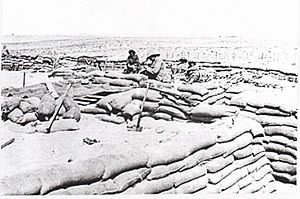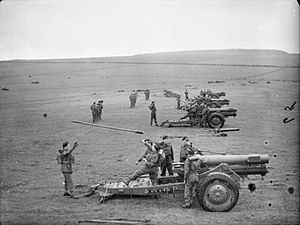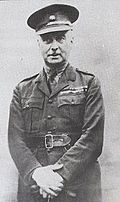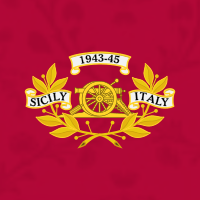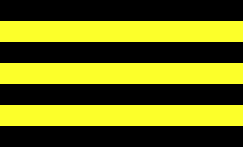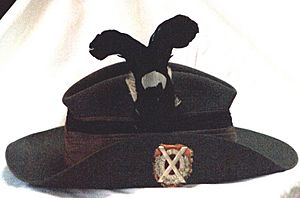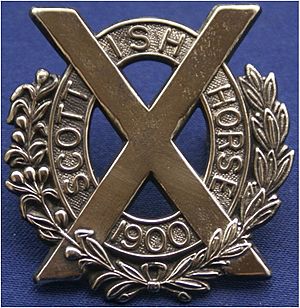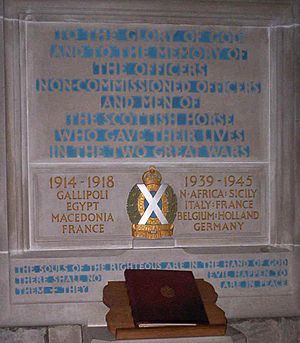Scottish Horse facts for kids
Quick facts for kids Scottish Horse |
|
|---|---|
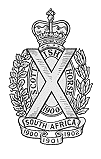
Cap badge of the Scottish Horse.
|
|
| Active | 1900–1956 |
| Country | |
| Branch | |
| Type | Yeomanry |
| Role | Formation Reconnaissance Infantry Artillery Army Air Corps |
| Size | Battalion |
| Colors | Black and Gold |
| March | The Scottish Horse The Garb of Old Gaul |
| Engagements | Anzio |
| Battle honours | Second Boer War 1900 – 1902 South Africa First World War Beaurevoir Selle Sambre France & Flanders Macedonia (1916–18) Gallipoli (1915) Romani Egypt (1915–16) Second World War North West Europe Sicily & Italy |
| Commanders | |
| Notable commanders |
Henry Peregrine Leader |
| Insignia | |
| Regimental Tartan (Murray of Atholl) |
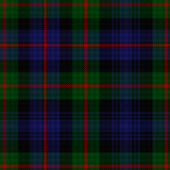 |
| Stable Belt Colours | 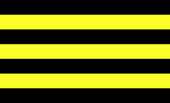 |
The Scottish Horse was a special kind of army unit called a Yeomanry regiment. It was part of the British Army's Territorial Army. It was first created in 1900 to fight in the Second Boer War.
This regiment fought bravely in both the First World War and the Second World War. In the First World War, it was known as the 13th Battalion, Black Watch. In the Second World War, it was part of the Royal Artillery. In 1956, the Scottish Horse joined with another unit, the Fife and Forfar Yeomanry. They became the Fife and Forfar Yeomanry/Scottish Horse. Today, their history is carried on by "C" Fife and Forfar Yeomanry/Scottish Horse Squadron. This unit is based in Cupar in Fife.
Contents
History of the Scottish Horse
How the Regiment Started
In late 1900, a leader named the Marquess of Tullibardine was asked to create a new army unit. Lord Kitchener asked him to gather Scotsmen in South Africa. This new unit was called The Scottish Horse.
The regiment was formed very quickly. Soon after, they started fighting in the Western Transvaal. A second Scottish Horse regiment was also created. It was made up of soldiers recruited by the 7th Duke of Atholl.
The war ended in June 1902. About 780 officers and men returned home to Britain. Both regiments were officially ended in Edinburgh Castle on September 1, 1902.
Reforming the Regiment
Later in 1902, the Scottish Horse was started again as two regiments. One was a British Army Regiment. The other was a volunteer regiment in the Transvaal Army, which later ended in 1907.
The British Army regiment was reformed in 1903. It was called the Scottish Horse Imperial Yeomanry. Its main office was in Dunkeld. It became the local Yeomanry Regiment for several areas, including Perthshire and Aberdeenshire.
By 1908, it was simply called the Scottish Horse. It had grown to two regiments with eight squadrons (smaller groups of soldiers). They were trained and equipped like dragoons, who were soldiers who rode horses but fought on foot.
The Scottish Horse in World War I
When World War I started in August 1914, many soldiers volunteered to serve overseas. The Scottish Horse units were split into different groups.
- 1st Line units were ready to fight abroad.
- 2nd Line units stayed home for defense.
- 3rd Line units trained new soldiers to replace those fighting.
Fighting Overseas: 1st Line Regiments
The 1st, 2nd, and 3rd Scottish Horse regiments formed a group called the Scottish Horse Mounted Brigade in 1914. By early 1915, they were defending the coast in the UK.
In August 1915, they were sent to fight overseas. They landed at Suvla Bay during the Gallipoli battles. They faced many dangers there. In December 1915, they had to leave Gallipoli and move to Egypt.
Because of many injuries and losses, the Scottish Horse Brigade was combined with another unit in February 1916. On September 29, 1916, the 1st and 2nd Regiments became an infantry (foot soldier) battalion. Two weeks later, they were named the 13th (Scottish Horse Yeomanry) Battalion, part of the Black Watch regiment. This battalion then went to fight in Salonika.
The 3rd Regiment became a special unit with Machine Gun Corps and continued to serve in Egypt. Later, it joined the Lovat's Scouts Battalion. In June 1918, this unit moved to the Western Front in France, where they stayed until the war ended.
Home Defense and Cyclists: 2nd Line Regiments
Three 2nd Line regiments were formed in 1914 in Dunkeld and Aberdeen. They moved to Kettering and later to Alford. In March 1916, they were renamed the 19th Mounted Brigade.
In July 1916, these regiments changed their role. They became cyclists and were part of the 12th Cyclist Brigade. They stayed in Lincolnshire. By the end of 1917, they moved to Fife. In April 1918, they went to Ireland and stayed there until the war finished.
Training Replacements: 3rd Line Regiments
Three 3rd Line regiments were formed in Dunkeld around May 1915. They trained new soldiers. In early 1917, these regiments were disbanded. Their soldiers either joined the 2nd Line units or the 4th (Reserve) Battalion of the Black Watch.
Between the World Wars
After World War I, the army decided that there were too many cavalry (horse-riding) units. Most cavalry regiments were changed to other roles. The Scottish Horse became a single regiment. It remained a "scouts" unit, meaning they still used horses for reconnaissance (finding out enemy positions).
The Scottish Horse in World War II
At the start of World War II, the Scottish Horse was still a mounted cavalry unit. However, their horses were soon taken away. In 1940, the Scottish Horse Regiment was split into two artillery units:
- The 79th (The Scottish Horse) Medium Regiment, Royal Artillery
- The 80th (The Scottish Horse) Medium Regiment, Royal Artillery
The 80th Medium Regiment fought in the Italian Campaign.
After the Wars
In 1947, the Scottish Horse rejoined the Territorial Army. Its main office was back in Dunkeld. It changed from being an artillery unit to being part of the Royal Armoured Corps (tank and armored vehicle units).
At this time, the regiment included two squadrons from the Scottish Horse and one from the Lovat Scouts. This combination did not last long. By 1949, the Lovat Scouts became an artillery unit again.
In 1956, it was announced that the Scottish Horse would join with the Fife and Forfar Yeomanry. On October 31, 1956, the Scottish Horse became part of a new regiment called the Fife and Forfar Yeomanry/Scottish Horse.
A Hero's Medal: The Victoria Cross
The Victoria Cross is the highest award for bravery in battle for British and Commonwealth soldiers. Lieutenant William John English (who later became Lieutenant Colonel) received this medal. He earned it for his amazing courage on July 3, 1901, in South Africa. He was serving as a lieutenant in The Scottish Horse.
His award citation said: This officer, with five men, was holding the position at Vlakfontein on 3 July 1901 during an attack by the Boers. Two of his men were killed and two wounded, but the position was still held, largely owing to the lieutenant's personal pluck. When the ammunition ran short, he went over to the next party and obtained more; to do so he had to cross some 15 yards of open ground, under a heavy fire at a range of from 20 to 30 yards.
Battle Honours and Achievements
Battle honours are special awards given to military units for their bravery in battles. The Scottish Horse's battle honours are shown on their guidon (a type of flag). This guidon is now kept in Dunkeld Cathedral. These honours were passed on to the guidon of the Fife and Forfar Yeomanry/Scottish Horse. Today, they are also on the guidon of the Queen's Own Yeomanry.
The Scottish Horse received many battle honours. Here are some of the most important ones:
- Second Boer War: South Africa 1900–02
- First World War: Beaurevoir, Selle, Sambre, France and Flanders 1918, Macedonia 1916–18, Gallipoli 1915, Rumani, Egypt 1915–16
- Second World War: The Royal Artillery, which the Scottish Horse became part of, fought in almost every major battle. Because of this, in 1833, King William IV gave the Royal Artillery the motto Ubique (meaning "everywhere") instead of individual battle honours.
The Scottish Horse also received an Honorary Distinction. This was a special badge from the Royal Regiment of Artillery. It included the years "1943–45" and mentioned their service in "North-West Europe", "Sicily", and "Italy".
Notable People from the Scottish Horse
Many important people served in the Scottish Horse. Here are a few:
- Lieut-Colonel William Anstruther-Gray
- Sir Frederick Charles Thomson
- John Baird, 1st Viscount Stonehaven: He was a British politician and the eighth Governor-General of Australia.
- Sir James Ramsay Montagu Butler
- Jock Wilson: He was Great Britain's oldest D-Day veteran.
- Noel Skelton
- Willie Thornton MM: A Scottish footballer and manager.
- William Wolfe: A leader of the Scottish National Party.
Uniform and Look
The soldiers of the Scottish Horse wore a special slouch hat. It had khaki and black silk on it. The commanding officer had a special silk made of the Murray of Atholl tartan. The hat also had a cap badge with yellow, red, or blue backing (depending on the regiment) and a black cock feather. The cap badge showed a cross of St Andrew with laurel and juniper leaves.
Officers and men wore the Duke of Atholl's Tartan, called Murray of Atholl, in different parts of their uniform. However, the pipers wore the Tullibardaine Tartan. Their stable belt was black with three gold stripes. These colors came from The Duke of Atholl's family crest.
In May 1903, the Scottish Horse showed off their full dress uniform for the first time. This was when King Edward VII visited Edinburgh. The uniform included the slouch hat, a light khaki-colored tunic with yellow trim, and tight-fitting cavalry trousers also with yellow trim. The yellow color matched the Scottish Standard flag.
In 1908, they adopted a more fancy full dress uniform in "Atholl Grey." This was a light grey color with a slight purple tint. The tunic and trousers were this color, with yellow collars, shoulder straps, and stripes. The slouch hat with black cock's tail feathers was still worn. This uniform was used for parades and special events until World War I began.
Memorials and Museums
You can find memorials to the Scottish Horse in several places:
- A memorial and the regiment's historical records are kept at Dunkeld Cathedral.
- There is a statue at Edinburgh Castle. It looks like a Cross of Iona with a sword and a lion. It says "Nemo me impune lacessit 1900."
- An identical memorial is in Kensington Ridge, Johannesburg, South Africa.
- A train engine, LMS Royal Scot Class number 6129, was named after the regiment. It ran from 1927 to 1964.
See also
- Imperial Yeomanry
- List of Yeomanry Regiments 1908
- Yeomanry
- Yeomanry order of precedence
- British yeomanry during the First World War
- Second line yeomanry regiments of the British Army
- List of British Army Yeomanry Regiments converted to Royal Artillery
- No. 655 Squadron AAC


